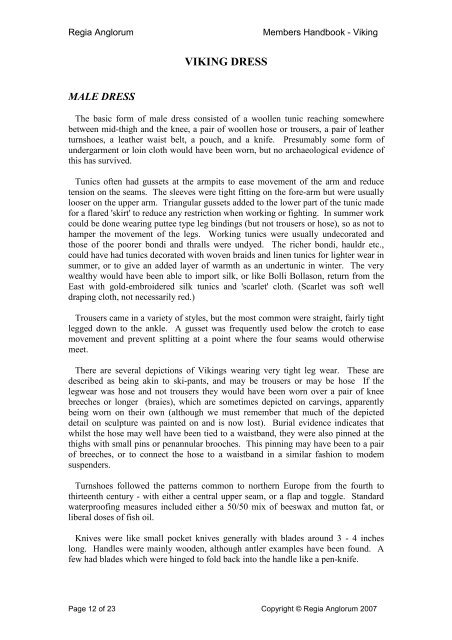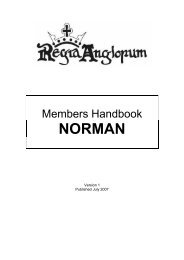You also want an ePaper? Increase the reach of your titles
YUMPU automatically turns print PDFs into web optimized ePapers that Google loves.
<strong>Regia</strong> <strong>Anglorum</strong> Members Handbook - Viking<br />
MALE DRESS<br />
VIKING DRESS<br />
The basic form of male dress consisted of a woollen tunic reaching somewhere<br />
between mid-thigh and the knee, a pair of woollen hose or trousers, a pair of leather<br />
turnshoes, a leather waist belt, a pouch, and a knife. Presumably some form of<br />
undergarment or loin cloth would have been worn, but no archaeological evidence of<br />
this has survived.<br />
Tunics often had gussets at the armpits to ease movement of the arm and reduce<br />
tension on the seams. The sleeves were tight fitting on the fore-arm but were usually<br />
looser on the upper arm. Triangular gussets added to the lower part of the tunic made<br />
for a flared 'skirt' to reduce any restriction when working or fighting. In summer work<br />
could be done wearing puttee type leg bindings (but not trousers or hose), so as not to<br />
hamper the movement of the legs. Working tunics were usually undecorated and<br />
those of the poorer bondi and thralls were undyed. The richer bondi, hauldr etc.,<br />
could have had tunics decorated with woven braids and linen tunics for lighter wear in<br />
summer, or to give an added layer of warmth as an undertunic in winter. The very<br />
wealthy would have been able to import silk, or like Bolli Bollason, return from the<br />
East with gold-embroidered silk tunics and 'scarlet' cloth. (Scarlet was soft well<br />
draping cloth, not necessarily red.)<br />
Trousers came in a variety of styles, but the most common were straight, fairly tight<br />
legged down to the ankle. A gusset was frequently used below the crotch to ease<br />
movement and prevent splitting at a point where the four seams would otherwise<br />
meet.<br />
There are several depictions of <strong>Vikings</strong> wearing very tight leg wear. These are<br />
described as being akin to ski-pants, and may be trousers or may be hose If the<br />
legwear was hose and not trousers they would have been worn over a pair of knee<br />
breeches or longer (braies), which are sometimes depicted on carvings, apparently<br />
being worn on their own (although we must remember that much of the depicted<br />
detail on sculpture was painted on and is now lost). Burial evidence indicates that<br />
whilst the hose may well have been tied to a waistband, they were also pinned at the<br />
thighs with small pins or penannular brooches. This pinning may have been to a pair<br />
of breeches, or to connect the hose to a waistband in a similar fashion to modem<br />
suspenders.<br />
Turnshoes followed the patterns common to northern Europe from the fourth to<br />
thirteenth century - with either a central upper seam, or a flap and toggle. Standard<br />
waterproofing measures included either a 50/50 mix of beeswax and mutton fat, or<br />
liberal doses of fish oil.<br />
Knives were like small pocket knives generally with blades around 3 - 4 inches<br />
long. Handles were mainly wooden, although antler examples have been found. A<br />
few had blades which were hinged to fold back into the handle like a pen-knife.<br />
Page 12 of 23 Copyright © <strong>Regia</strong> <strong>Anglorum</strong> 2007



